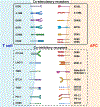Immune checkpoints in autoimmune vasculitis
- PMID: 38599937
- PMCID: PMC11366503
- DOI: 10.1016/j.berh.2024.101943
Immune checkpoints in autoimmune vasculitis
Abstract
Giant cell arteritis (GCA) is a prototypic autoimmune disease with a highly selective tissue tropism for medium and large arteries. Extravascular GCA manifests with intense systemic inflammation and polymyalgia rheumatica; vascular GCA results in vessel wall damage and stenosis, causing tissue ischemia. Typical granulomatous infiltrates in affected arteries are composed of CD4+ T cells and hyperactivated macrophages, signifying the involvement of the innate and adaptive immune system. Lesional CD4+ T cells undergo antigen-dependent clonal expansion, but antigen-nonspecific pathways ultimately control the intensity and duration of pathogenic immunity. Patient-derived CD4+ T cells receive strong co-stimulatory signals through the NOTCH1 receptor and the CD28/CD80-CD86 pathway. In parallel, co-inhibitory signals, designed to dampen overshooting T cell immunity, are defective, leaving CD4+ T cells unopposed and capable of supporting long-lasting and inappropriate immune responses. Based on recent data, two inhibitory checkpoints are defective in GCA: the Programmed death-1 (PD-1)/Programmed cell death ligand 1 (PD-L1) checkpoint and the CD96/CD155 checkpoint, giving rise to the "lost inhibition concept". Subcellular and molecular analysis has demonstrated trapping of the checkpoint ligands in the endoplasmic reticulum, creating PD-L1low CD155low antigen-presenting cells. Uninhibited CD4+ T cells expand, release copious amounts of the cytokine Interleukin (IL)-9, and differentiate into long-lived effector memory cells. These data place GCA and cancer on opposite ends of the co-inhibition spectrum, with cancer patients developing immune paralysis due to excessive inhibitory checkpoints and GCA patients developing autoimmunity due to nonfunctional inhibitory checkpoints.
Keywords: Antigen-presenting cell; CD155; CD96; Co-inhibition; Costimulation; PD-1; PD-L1; T cells.
Copyright © 2024 Elsevier Ltd. All rights reserved.
Conflict of interest statement
Declaration of competing interest The authors declare that they have no known competing financial interests or personal relationships that could have appeared to influence the work reported in this paper.
Figures



References
-
- Jennette JC, Falk RJ, Bacon PA, Basu N, Cid MC, Ferrario F, et al. 2012 revised International Chapel Hill Consensus Conference Nomenclature of Vasculitides. Arthritis Rheum. 2013;65(1):1–11. - PubMed
-
- McCrindle BW, Rowley AH, Newburger JW, Burns JC, Bolger AF, Gewitz M, et al. Diagnosis, Treatment, and Long-Term Management of Kawasaki Disease: A Scientific Statement for Health Professionals From the American Heart Association. Circulation. 2017;135(17):e927–e99. - PubMed
-
- Bilginer Y, Ozen S. Polyarteritis nodosa. Curr Opin Pediatr. 2022;34(2):229–33. - PubMed
-
- Kitching AR, Anders HJ, Basu N, Brouwer E, Gordon J, Jayne DR, et al. ANCA-associated vasculitis. Nat Rev Dis Primers. 2020;6(1):71. - PubMed
Publication types
MeSH terms
Substances
Grants and funding
LinkOut - more resources
Full Text Sources
Medical
Research Materials

